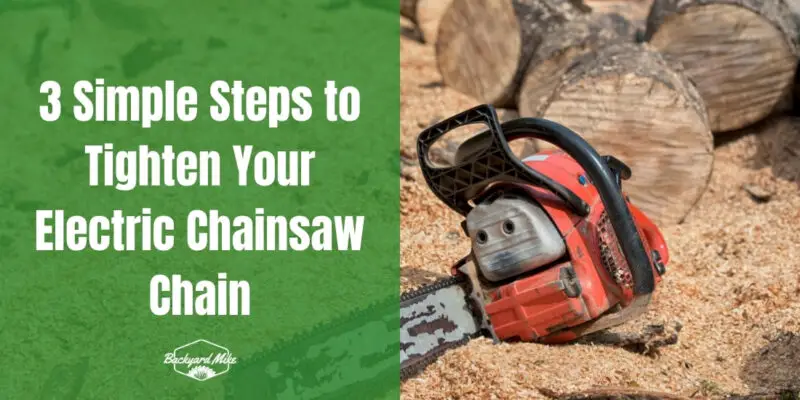First, confirm safety by disconnecting the power source and wearing gloves. Slightly loosen the bar nuts, then turn the tension adjustment screw near the bar mounting point clockwise to tighten or counterclockwise to loosen, holding the bar tip up. The chain should resist slightly without being too tight or loose. Finally, test tension by pulling the chain downward; it should snap back into place. Keep confirming your chainsaw is in top condition.
Key Takeaways
- Begin by loosening the bar nuts slightly to allow for chain adjustments.
- Locate and turn the tension adjustment screw near the bar mounting point.
- Adjust chain tension by turning the screw clockwise to tighten or counterclockwise to loosen.
- Lift the bar tip while adjusting to ensure proper chain alignment and tension.
- Check tension by ensuring the chain snaps back when pulled down without sagging.
Preparation and Safety Measures
Before tightening an electric chainsaw chain, you must prepare properly to guarantee safety and efficiency. Start by ensuring tool safety; gather a flathead screwdriver, safety gloves, and chainsaw pliers. Check the chain for damage or excessive wear to maintain effective chain maintenance. Clear your work area of debris, ensuring a safe environment. Always disconnect the power source; unplug corded chainsaws, remove the battery, or spark plug, as applicable. Engage the chain brake to prevent accidental starts and wear your safety gloves to protect against sharp chain teeth. Conduct a thorough inspection of the guide bar for wear to prevent uneven tension. Regular inspection is crucial. Electric chainsaws are environmentally friendly as they have zero emissions during operation, making them a preferred choice for many users. New chains require breaking in and adjustment within the first five cuts to ensure proper tension. These preparation steps foster a sense of belonging among chainsaw users who prioritize safety and precision.
Adjusting the Chain Tension
After guaranteeing safety and preparation, it's time to adjust the chain tension on your electric chainsaw.
Begin by loosening the bar nuts slightly, ensuring they remain on the bar. Next, locate the tension adjustment screw near the bar mounting point. Use a screwdriver or wrench to turn the screw clockwise to tighten the chain or counterclockwise to loosen it. Lift the bar tip while adjusting to guarantee proper alignment. Perform a tension check by pulling the chain gently; it should resist slightly without being too tight or loose. Remember that tightening immediately after use can be risky due to the potential for burns from hot components. Ensuring your chainsaw is equipped with a tool-free chain tensioning system can make adjustments more convenient and efficient.
Regular chain maintenance is essential, so check tension frequently, especially after prolonged use. Maintaining the correct tension helps prevent accidents and prolongs your chain's lifespan, securing safer operation and effective performance.
Testing and Finalizing Adjustments
How do you guarantee your electric chainsaw is ready for action after making adjustments?
Start by testing chain performance. Make certain the tension is consistent by pulling the chain downward; it should snap back into place without sagging. This enhances cutting efficiency and reduces kickback risk. Remember to always wear gloves when handling the bar and chain to ensure safety.
Next, verify oil distribution. Run the saw near cardboard to check for an even oil spray pattern, confirming the oil pump's function. Inspect the chain for an oily film on drive links to prevent overheating. Make sure the automatic lubrication system is functioning properly, as it simplifies routine maintenance and extends the lifespan of the tool.
Secure all bolts, then test the saw on a small log to evaluate cutting performance. Keep your work area safe and always wear protective gear.
With these steps, you'll make certain your chainsaw operates effectively and safely.
Frequently Asked Questions
How Often Should I Check My Chainsaw Chain Tension?
You've got to check your chainsaw chain tension regularly. For ideal chain maintenance, adjust the tension before each use, during operation, and every 10-15 minutes if used extensively. This guarantees safety, performance, and a sense of belonging within the community.
What Causes Chainsaw Chains to Loosen Over Time?
You'll notice your chainsaw chain loosens over time due to chain wear and tension adjustments. Frequent checks guarantee you stay connected with your tool, maintaining safety and performance. Embrace these steps to belong in the chainsaw community.
Can I Use My Chainsaw Without Lubricating the Chain?
You can't operate your chainsaw without proper lubrication. It's essential for chain maintenance and overall safety. Guarantee regular lubrication to prevent overheating, avoid damage, and keep your chainsaw community ready and functioning efficiently.
What Are the Signs of a Worn-Out Chainsaw Chain?
Think of a worn-out chainsaw chain like a dull pencil; it just can't perform well. You'll notice chain wear through smoke, rough cuts, and increased effort, all signaling diminished cutting performance. Keep it sharp to belong.
How Does Temperature Affect Chainsaw Chain Tension?
You're part of a community that knows temperature fluctuations cause chainsaw chain expansion or contraction. Check tension regularly, especially after temperature changes, to maintain safety and performance. Ensuring your chain's ideal tension keeps you cutting confidently.
Conclusion
By following these steps, you'll keep your electric chainsaw chain as reliable as a well-oiled machine. Start with the right preparation and safety measures to set a solid foundation. Adjust the chain tension carefully, ensuring it's neither too tight nor too loose. Finally, test the adjustments to confirm everything is secure. With these straightforward actions, you'll maintain your chainsaw's performance and safety, ready to tackle any cutting task with confidence and precision.


